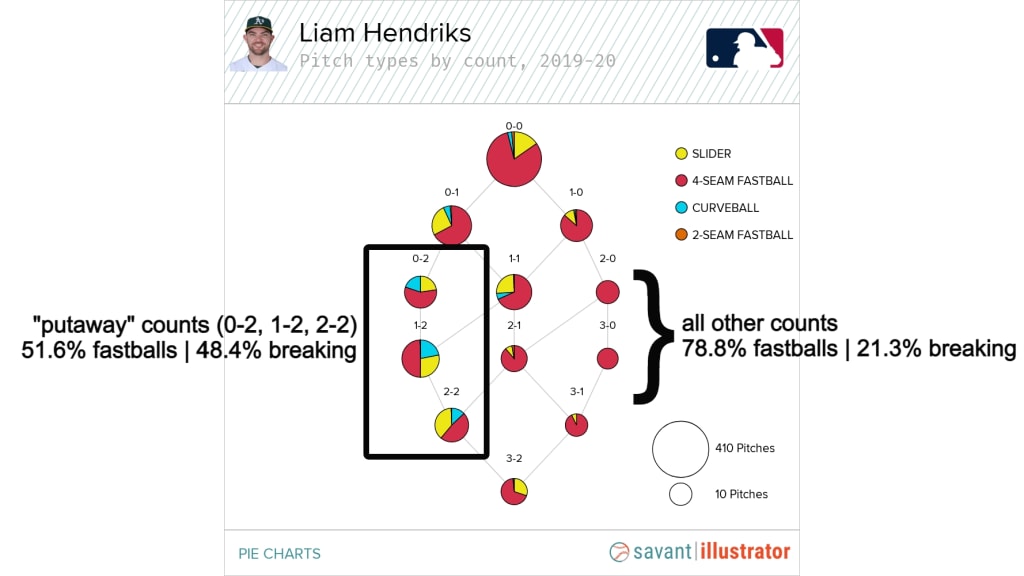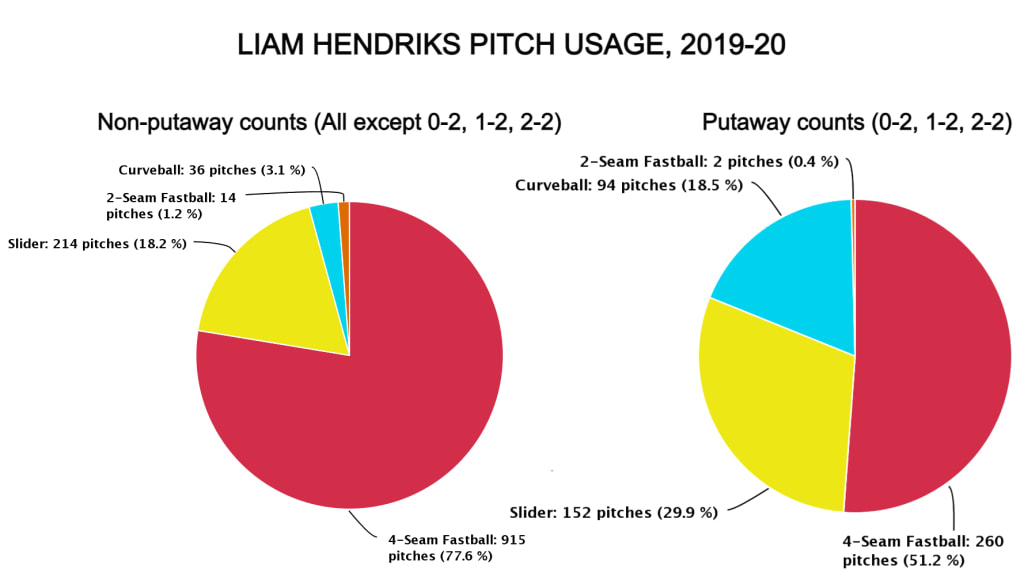They say the fastball count is dying. Don't tell Liam Hendriks.
The reigning American League Reliever of the Year -- who finalized a four-year deal with the White Sox on Friday -- got to this point with an old-school approach to attacking hitters.
Hendriks pumps fastballs until he gets ahead. Once he gets to two strikes, he starts throwing his two breaking balls just as often as his four-seamer. He's predictable until he's not, and by the time he's not, you're in trouble.
The 31-year-old right-hander has, essentially, one setup pitch -- his fastball -- but three putaway pitches: his fastball, slider and curveball. Hendriks' "attack early, spin late" approach separates him from pitchers like the other top closer in the free-agent class, Brad Hand, who throws sliders more than half the time. It's what helps make Hendriks the most overpowering reliever on the market.

Let's say a "putaway" count is 0-2, 1-2 or 2-2, where the pitcher has a strikeout set up (3-2 is a little different because it's an action pitch, where the pitcher also risks walking the batter). Hendriks' split between what he throws on putaway counts and non-putaway counts is notable, especially in releation to the trend of MLB overall.
On non-putaway counts, which encompass the more traditional "fastball counts," the league fastball percentage has dropped five years in a row.
League fastball % in non-putaway counts since 2015
(4-seamer/sinker usage in all counts except 0-2, 1-2, 2-2)
2015: 59.8%
2016: 59.1%
2017: 58.7%
2018: 57.7%
2019: 54.9%
2020: 52.9%
When pitch tracking started in 2008, MLB pitchers were throwing over 60% fastballs in non-putaway counts. Now they're barely throwing 50% fastballs in those counts.
And then you see a pitcher like Hendriks, holding fast on the other end. Over the past two seasons, Hendriks has thrown 78.8% fastballs in non-putaway counts, one of the highest rates in the Major Leagues.
Highest fastball usage in non-putaway counts, 2019-20
Of 258 pitchers with 1,000+ tracked pitches in non-putaway counts
- Richard Rodríguez: 84.6%
- Josh Hader: 83.6%
3) Liam Hendriks: 78.8%
4-T) Chad Green: 78.1%
4-T) Jared Hughes: 78.1%
But those other pitchers like Rodríguez, Hader and Green are fastball-heavy regardless of count. Hendriks isn't. In putaway counts -- on 0-2, 1-2 and 2-2 -- Rodríguez throws 74.8% fastballs, Hader throws 72.7% fastballs and Green throws 73.4% fastballs.
Hendriks? He only throws 51.6% fastballs in putaway counts, basically a fastball-breaking ball coin flip. He can keep throwing fastballs to get the strikeout, but he's also just as likely to throw his secondary stuff.
Here's Hendriks' pitch mix from 2019-20:
Hendriks in non-putaway counts: 78.8% fastballs, 21.3% breaking balls
Hendriks in putaway counts: 51.6% fastballs, 48.4% breaking balls

If you're a hitter, you know Hendriks is going to attack you early. But once you're in the hole, you don't know what's coming for the strikeout. It could be the four-seamer, but it just as easily could be the curveball or slider. Since 2019, 78 of Hendriks' 161 strikeouts have been on fastballs; 83 have been on breaking balls (54 on sliders, 29 on curveballs). This season, he had slightly more on fastballs than breaking balls; in 2019 it was flipped.
So … why does it all work?
Start with the early counts. Hendriks is obviously going to come with his fastball, but it's a great fastball.
He's throwing it harder. Over Hendriks' first four seasons as a reliever from 2015-18, his average fastball velocity was 94.9 mph; over the past two seasons, it's 96.3 mph, a +1.4 mph increase. And it's a rising fastball, with both high spin and efficient spin. Hendriks' fastball gets about three inches more rise than an average four-seamer, putting it in the top 10 in MLB in rising movement in 2019 and in the top five in MLB in 2020.
Top rising fastballs in 2020
Movement compared to 4-seamers thrown with similar velocity + release point
- Trevor Bauer: +3.9 inches above avg.
- James Karinchak: +3.6 inches above avg.
- Walker Buehler: +3.5 inches above avg.
4) Liam Hendriks: +3.2 inches above avg.
5-T) 4 pitchers tied at +3.1 inches above avg.
High-spin, high-velocity rising fastballs like Hendriks' are simply harder to hit. They get more swings-and-misses. That's why Hendriks can attack the zone with his four-seamer earlier in at-bats.
Then comes his breaking-ball combo. Hendriks' slider and curveball are both power breaking balls, with his slider in the upper 80s and his curve in the mid-80s (the slider is more for righties and the curveball is more for lefties, but Hendriks will mix in both to batters of either side). They don't have a lot of horizontal break, so they come in on a similar track to his fastball, until they take a dive down out of the strike zone.
Hendriks' four-seamer will only drop about 10 inches on its way to the plate. His slider will drop about 30 inches. And his curveball will drop about 50 inches. Those are 20-inch vertical movement steps from fastball to slider to curveball.
And when Hendriks is ahead, with two strikes on the hitter, either heat or breaking stuff could be coming. It's hard not to strike out … which is why 40% of batters do. And why Hendriks strikes out over 13 batters per nine innings. And it's why the White Sox just picked up a dominant closer.
